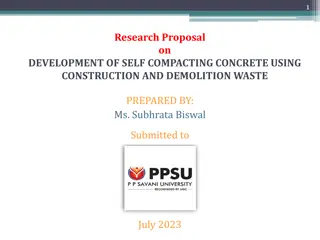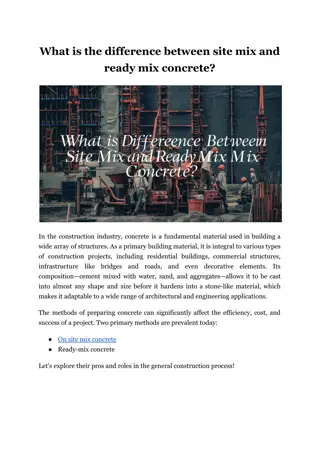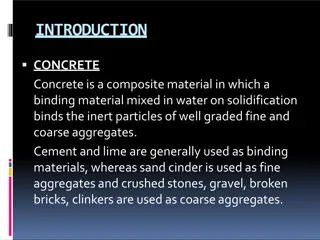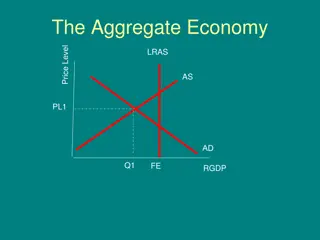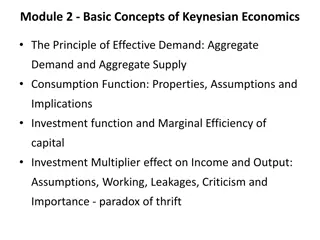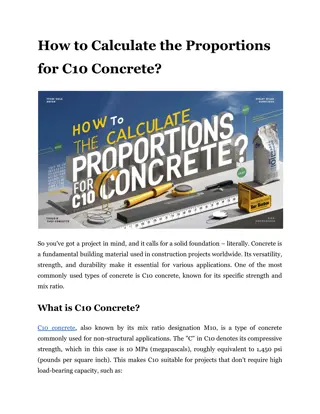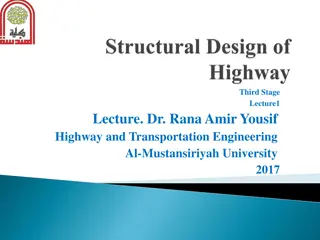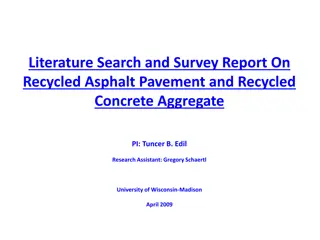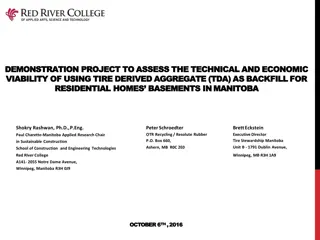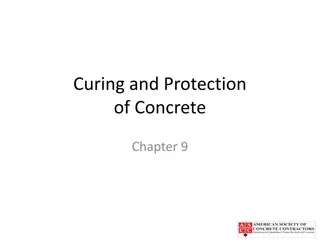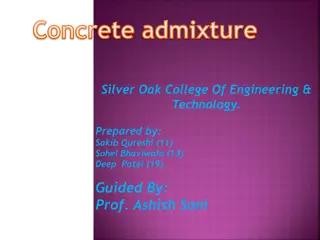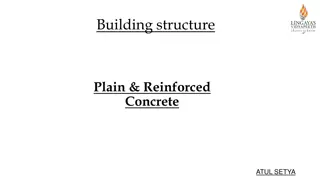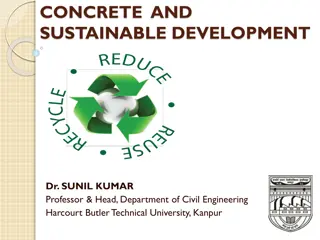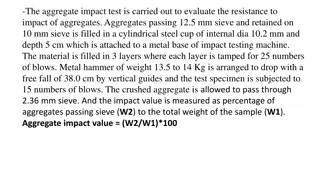Concrete Mix Design: Optimal Proportions & Aggregate Gradation
Concrete mix design is crucial for achieving the desired properties and performance of concrete. The Maximum Aggregate Density Mix Design method helps determine the best proportions for Portland Cement Concrete. Utilizing combined aggregate gradation near the maximum density line can reduce shrinkage. Critical aggregate properties, acceptable cementitious materials, admixtures, and fiber options are essential considerations for successful concrete mix designs.
Download Presentation

Please find below an Image/Link to download the presentation.
The content on the website is provided AS IS for your information and personal use only. It may not be sold, licensed, or shared on other websites without obtaining consent from the author.If you encounter any issues during the download, it is possible that the publisher has removed the file from their server.
You are allowed to download the files provided on this website for personal or commercial use, subject to the condition that they are used lawfully. All files are the property of their respective owners.
The content on the website is provided AS IS for your information and personal use only. It may not be sold, licensed, or shared on other websites without obtaining consent from the author.
E N D
Presentation Transcript
ATM for Concrete Mix Designs Rich Giessel, ADOT&PF
ATM 530 ATM 530Concrete Mix Design by Maximum Aggregate Density Scope This method describes the Maximum Aggregate Density Mix Design procedure for determining the optimum proportions for Portland Cement Concrete both with and without supplemental cementitious materials.
Significance Concrete proportions, properties and performance depend on the aggregate that forms most of the matrix of this composite material. Many proportioning methods have been used historically to produce concrete. This method utilizes the maximum aggregate density procedure.
Combined Aggregate Gradation Combined Aggregate gradations that plot near the maximum density line on a gradation curve typically require less cementitious material and produce concretes with lower shrinkage than concretes that use open- graded aggregate mixtures.
Critical Aggregate Properties Aggregate properties important to concrete mix design include; absorption, apparent, bulk SSD, and bulk specific gravity of each fine & coarse aggregate. Sodium Sulfate Soundness or Freeze/Thaw durability, Deleterious particles, Aggregate hardness (for pavements) ASR is almost never a problem in Alaska
Cementitious Materials Cementitious materials acceptable for concrete shall include; Portland Cement, Class C and F Fly Ash, Ground, Granulated Blast Furnace Slag (GGBF), Silica Fume, and Meta- Kaolin.
Admixtures Admixture materials acceptable for concrete shall include, water-reducers, surfactants, viscosity modifiers, air-entrainment, crack reducers, shrinkage reducers, accelerators, retarders, water proofers, surface sealers and hardeners.
Fibers Fiber materials are acceptable for reinforcement, shrinkage and crack control in concrete and shall include; steel, stainless steel, synthetic, and alkali-resistant cellulose fibers.
Internal Curing Internal curing materials include; expanded shale clay or slate fine aggregates, alkali- resistant cellulose, super-absorbent polymers, and naturally occurring aggregates of volcanic origin meeting ASTM C1761.
Apparatus Ovens and hot plates thermostatically controlled to maintain the various required temperatures within 3 C (5 F). Fresh Concrete Testing equipment for Slump, Air, Unit Weight, and Temperature, AASHTO T 119, T 152, T 121, and T 309 respectively. Water bath with temperature control sensitive to 0.2 C (0.5 F) at 23 C (73.4 F) per AASHTO T 85. Balance or scale: Capacity sufficient for the principal sample mass, readable to 0.1 percent or 0.1 g of the total sample mass and meeting the requirements of AASHTO M 231. Sieve shaker meeting the requirements of WAQTC FOP for AASHTO T 27/T 11. Specimen molds, either 4x8 or 6x12 with lid that conform to ASTM C470. Compression Testing machine meeting the requirements of ASTM C39 and referenced documents. Surface Resistivity testing apparatus meeting the requirements of AASHTO TP 95. Restrained Shrinkage testing apparatus meeting the requirements of ASTM C1581.
Proportioning Concrete Determine the volume of voids in the combined SSD aggregate. Determine required entrained air content for exposure conditions and maximum aggregate size. Determine if fiber reinforcement will be required. Select w/c ratio based on compressive strength requirements. Calculate volume of paste required to fill remaining voids and provide desired workability. Calculate admixture volumes required to produce required entrained-air content and workability.
Trial Batches, Minimum of 3 or 5? A minimum of three trial batches for no-air concrete and five trial batches for air-entrained will be required to establish w/c vs. strength and air vs. strength relationships. Typically it is best to begin with no-air concrete to establish w/c vs. strength relationship. If done well and the middle no-air batch falls near the optimum w/c ratio then that batch may also be used in establishing the air vs. strength relationship provided the additional batches are made at the same w/c ratio. The two subsequent air-entrained batches should be made near the upper and lower limits of the specified air content.
First Trial Batch Prepare first trial batch and check for workability, under-sanded or over-sanded, entrained-air content. This may require multiple First trial batches
Subsequent Trial Batches If first trial batch mix parameters are satisfactory then proceed with two additional trial batches with same volume of paste but higher and lower cement contents (lower and higher w/c ratios respectively) Make sure high w/c mix falls below minimum compressive strength and lower w/c ratio exceed f cr. If the initial trial batch is not near the middle of w/c range then prepare a fourth batch near the optimum w/c ratio. For air-entrained concrete you will need at least two additional trial batches at optimum w/c ratio to produce the % Air vs. Strength curve.
Fresh Concrete Properties Test for: Temperature Slump (flow if SCC mix) Wet unit weight Entrained-air content
Preparing Concrete Test Specimens for High Performance Concrete Cast one set of restrained shrinkage specimens for each trial batch per ASTM C1581. Measure and record all data for each set of specimens and include it in mix design report. Cast 15 test cylinders (4x8)
Test Cylinders Cast 15 each 4x8 or 10 each 6x12 test cylinders for compressive strength testing of each trial batch. For Type I/II cement break 3each 4x8 or 2 each 6x12 specimens at 3, 7, 14, 28 days and hold three specimens for possible break at a later age. (Note: High fly ash content concretes may continue to gain significant strength for several years. Additional test specimens should be cast for these mixes as compressive strength at 56 days, 90 days, 1 year and 2 years may be significant.) For Concrete made with Type III cement break 3each 4x8 or 2 each 6x12 specimens at 1,2, 3, 7 days and hold three specimens for possible break at a later age.
Curing of Specimens Cure compressive and flexural specimens in fog room or water bath as specified in ASTM C511
Hardened Concrete Properties Remove test specimens from molds 24 4 hours after casting. Determine hardened unit weight of all specimens by soaking test specimens in 230C water for 15 minutes then weighing in water followed by weighing in air at SSD. Immediately prior to compression testing determine the Resistivity of each specimen by AASHTO TP 95. Record resistivity for each specimen, average each set of readings and include data in mix design report. When flexural strength is required cast three beams in accordance with ASTM C78. Test at the required age and include data in mix design report.
Graphing Test Results Graph the 28 day compressive strength vs. w/c ratio for the no-air trial batches. Graph the 28 day compressive strength vs. air content and provide the linear equation for the data. Graph the age vs. compressive strength for the trial batch that falls nearest to the optimum mix design.
Determine Optimum w/c Ratio From 28 day compressive strength vs. air content equation compute loss of strength from no-air test values to optimum air content. From the graph of compressive strength vs. w/c ratio adjusted by compressive strength loss due to optimum air content, select w/c ratio that will give mix with required f cr. This will provide the proportions for a Proof Batch at the selected mix design proportions. (DOT&PF typically requires materials for a proof batch to verify concrete mixes made from material without a previous history.)
Mix Design Report The report shall include the following: Project identification, Source/Supplier of mix and name of the general contractor Aggregate source(s), quality identification(s), target gradation, blend ratio of individual stockpiles, blended absorption, apparent, bulk SSD, and bulk specific for Coarse and Fine Aggregate Fractions. Other properties that may be specified in the Contract include: fineness modulus of the blended fine aggregate; percent flat and elongated; sodium sulfate soundness of coarse and fine aggregate fractions, or aggregate-silica reactivity (ASR). Graphical representation on a 0.45 power graph of the combined aggregate gradation with the Lower Specification Limit (LSL) and Upper Specification Limit (USL). Identification and address of the laboratory that performed the mix design, that laboratories mix design identification number and the signed seal of the professional engineer who reviewed and approved the mix design.
Duplicate Coarse Aggregate SpG Formulas: Description: Trial 1 Trial 2 Average A Oven dry mass in air (g) 2869.0 2892.6 B SSD mass in air (g) 2907.8 2933.5 C Mass in water (g) 1820.8 1836.2 T Temperature, C 23.4 23 A/(B-C) Bulk Sp.G (oven dry) 2.639 2.636 2.638 B/(B-C) SSD Sp.G 2.675 2.673 2.674 A/(A-C) Apparent Sp.G 2.737 2.738 2.738 100[(B-A)/A] % Absorption 1.35% 1.41% 1.38%
Duplicate Fine Aggregate SpG Description of data or calculation: Formulas: Trial 1 Trial 2 Average B Pyc+ Distilled Water (from calib) Ave M pw, c (g) 660.7 660.7 S SSD Soil Mass 500.1 500.8 C Pyc + Distilled Water + Agg 973.7 974.5 T Temperature (23.0 2.0 C) 23.0 22.7 A Oven Dry Mass 493.4 495.3 A/(B+S-C) S/(B+S-C) A/(B+A-C) Bulk Sp.G. (Oven Dry) SSD Sp.G. Apparent Sp.G. 2.637 2.673 2.735 2.649 2.678 2.729 2.643 2.675 2.732 100(S-A)/A Absorption 1.36% 1.11% 1.23%
Combined Concrete Aggregate Grading Nominal Maximum Aggregate Size Sieves 3 3 2 2 1 1 No. 4 No. 8 No. 16 No. 30 No. 50 No. 100 No. 200 3 2- 2 1- 1 No. 4 99-100 93-100* 99-100 92-100* 99-100 90-100* 76-90 66-79 54-66 47-58 38-48 33-43 22-31 15-23 9-17 5-12 2-9 0-7 0-2.0 99-100 87-100* 71-88 58-73 51-64 41-54 35-47 24-34 16-25 10-18 6-14 2-10 0-7 0-2.0 99-100 82-100* 64-83 55-73 45-61 39-54 26-39 17-29 11-21 6-15 3-11 0-8 0-2.0 99-100 87-100* 62-88 99-100 81-100* 57-83 99-100 86-100* 43-64 29-47 19-34 12-25 7-18 3-14 0-10 0-2.0 60-88 41-64 27-47 17-34 9-25 4-18 0-14 0-2.0 99-100 68-100* 34-54 22-39 14-29 8-21 3-15 0-11 0-2.0 48-73 31-54 20-39 11-29 5-21 0-15 0-2.0 39-73 24-54 13-39 6-29 0-21 0-2.0 28-73 16-54 7-39 0-29 0-2.5
Combined Aggregate Calculation B L E N D R E Q U I R E D - % 0 0 0 0 3/4" 45.3 Pea 16.2 Pea - Sand 38.5 F. Sand 0 100 ACCUMULATED P E R C E N T P A S S I N G 3/4" B L E N D E D A G G R E G A T E S MATERIAL SPECIFICATION SIEVE SIZE (us) 1-1/2" Pea C. Sand F. Sand (mm) 37.5 100 100 100 100 100 100 100% 100 1.0" 25 100 100 100 100 100 100 100% 99-100 3/4" 19 100 100 96 100 100 100 98.2 % 87-100 1/2" 12.5 100 100 53 100 100 100 78.7 % 3/8" 9.5 * 100 32 95 100 100 68.4 % 60-88 1/4" 6.3 * 0.0 % #4 4.75 * 0 12 33 99 99 48.9 % 41-64 #8 2.36 * 0 3 5 92 97.4 37.6 % 27-47 #16 1.18 * * 2 2 72 96 29.0 % 17-34 #30 0.3 * * * 1 45 94.7 17.5 % 9-25 #50 0.3 * * * * 14 81.3 5.4 % 4-18 #100 0.15 * * * * 4 29.6 1.5 % 0-14 #200 0.075 0 0 1.3 0.7 1.7 6.7 1.4 % 0 - 2.0 Amount (lbs) % Total 11,360 45.3% 4,060 16.2% 9,660 38.5% 25,080Total Agg on Truck Ticket
Combined Aggregate 0.45 Power 0.45 POWER CHART 100 90 80 70 % Passing 60 50 40 30 20 10 0 2.36 4.75 1.18 12.5 37.5 9.5 19 50 0.15 0.6 0.3 Sieve Size (mm)
Strength vs w/c Ratio Strength vs. Water / Cement Ratio 7800 7700 3 Day psi 7400 7 Day psi 7120 7000 14 Day psi 6650 28 Day psi 6600 6300 6200 6130 5900 Compressive Strength (psi) 5800 5640 5400 5260 5000 4590 4600 4540 4200 3800 3520 3400 3000 2700 2600 0.40 0.41 0.42 0.43 0.44 0.45 0.46 0.47 0.48 0.49 0.50 Water / Cement Ratio
No Air Strength vs Age Strength vs. Age 8000 7500 7000 6500 6000 5500 Strength (psi) 7.0 Sack 5000 6.5 Sack 4500 6.0 Sack 4000 3500 3000 2500 2000 0 5 10 15 20 25 30 Age (days)
Strength vs Air Content 28 Day Strength vs. % Air for three batches at W/C = 0.400 8000 7500 y = -827x + 9893 7000 6500 Compressive Strength (psi) 6000 5500 5000 4500 4000 3500 3000 2.0 3.0 4.0 5.0 6.0 7.0 8.0 % Air by Volume
Y = mx + b Strength vs. Air % W/C Ratio Air Test % Strength (psi) 0.400 3.0 7410 0.400 5.1 5675 0.400 6.6 4335
Strength vs Air, Linear Equation Y = mx + b Where: m = Slope, Loss of psi/1.0 %Air = -827 b = y intercept = 9893 Compressive Strength = -827(% Air) + 9893 psi 8% Air gives: = -827(8) + psi 9893 = 3277
Air-Entrained Strength vs Age Strength vs. Age 6000 5500 5000 4500 Strength (psi) 4000 7.5 Sack 7.0 Sack 6.5 Sack 3500 6.0 Sack 3000 2500 2000 0 5 10 15 20 25 30 Age (days)



